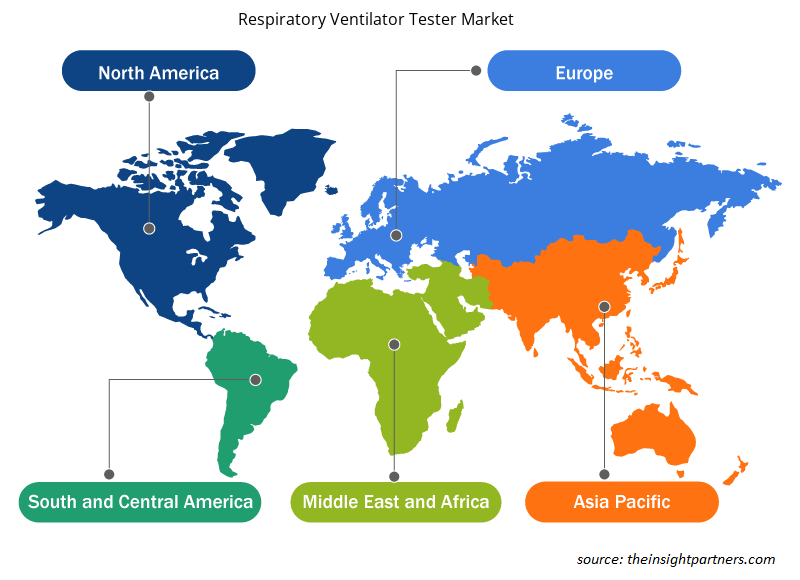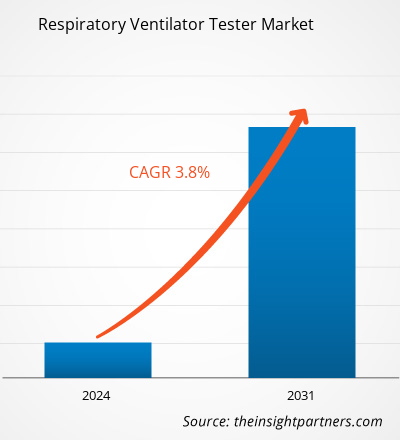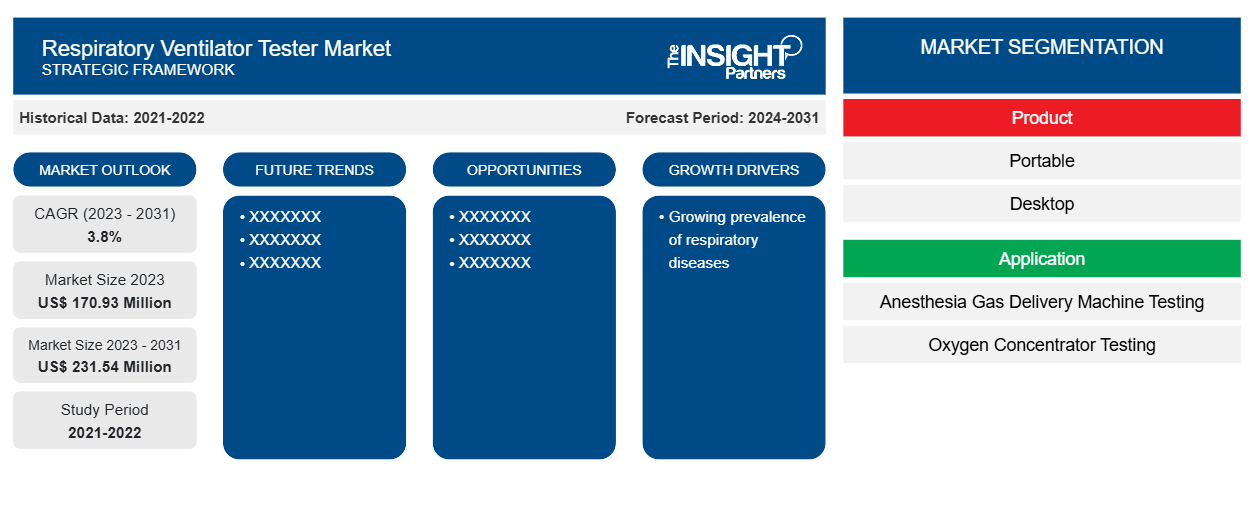Se proyecta que el tamaño del mercado de probadores de ventiladores respiratorios alcance los 231,54 millones de dólares estadounidenses para 2031, desde los 170,93 millones de dólares estadounidenses en 2023. Se espera que el mercado registre una CAGR del 3,8 % entre 2023 y 2031. Es probable que la creciente prevalencia de enfermedades respiratorias, la creciente demanda de probadores de ventiladores en los hospitales y los avances tecnológicos en los probadores de ventiladores para medir los parámetros vitales sigan siendo tendencias clave del mercado de probadores de ventiladores respiratorios.
Análisis del mercado de comprobadores de ventiladores respiratorios
La creciente carga de enfermedades respiratorias y el envejecimiento cada vez mayor de la población propensa a varias dolencias respiratorias están aumentando el crecimiento del mercado. Por ejemplo, según los datos publicados en el artículo de Jama Network Open en diciembre de 2023, la prevalencia de EPOC en 2020 entre hombres y mujeres se estimó en un 10,6%, lo que supone aproximadamente 480 millones de casos. Se proyecta que los casos de EPOC aumentarán en 112 millones hasta un total de 592 millones para 2050, especialmente entre las mujeres y las regiones de ingresos bajos y medios. Por lo tanto, se proyecta que la enorme carga de EPOC, que es una de las principales enfermedades respiratorias, aumentará la demanda general de su tratamiento y requerirá probadores de ventiladores, lo que impulsará el mercado de probadores de ventiladores respiratorios durante el período de pronóstico.
Descripción general del mercado de comprobadores de ventiladores respiratorios
América del Norte es el mercado más grande para el crecimiento del mercado de probadores de ventiladores respiratorios, y Estados Unidos tiene la mayor participación de mercado, seguido de Canadá. Se prevé que factores como la creciente prevalencia de trastornos respiratorios, los avances tecnológicos en la industria de dispositivos médicos y el creciente envejecimiento de la población propensa a varias enfermedades respiratorias impulsen aún más el mercado general de probadores de ventiladores respiratorios de América del Norte. Por ejemplo, según el artículo publicado en Aging and Disease en agosto de 2023, las infecciones respiratorias fueron un problema de salud importante entre la población que envejece, particularmente durante la pandemia de COVID-19 en 2020. El aumento de las tasas de mortalidad y morbilidad se observó principalmente entre la población mayor de 65 años. El proceso normal de envejecimiento entre la población que envejece en los pulmones aumenta la vulnerabilidad a las infecciones respiratorias debido al daño celular y la acumulación de senescencia. Por lo tanto, la creciente población que envejece y sufre infecciones respiratorias demandará probadores de ventiladores, lo que impulsa aún más el mercado de probadores de ventiladores respiratorios de América del Norte.
Personalice este informe según sus necesidades
Obtendrá personalización en cualquier informe, sin cargo, incluidas partes de este informe o análisis a nivel de país, paquete de datos de Excel, así como también grandes ofertas y descuentos para empresas emergentes y universidades.
-
Obtenga las principales tendencias clave del mercado de este informe.Esta muestra GRATUITA incluirá análisis de datos, desde tendencias del mercado hasta estimaciones y pronósticos.
Factores impulsores y oportunidades del mercado de comprobadores de ventiladores respiratorios
La creciente prevalencia de trastornos respiratorios demanda un sistema de prueba de ventiladores respiratorios que favorece el mercado
Se espera que la creciente prevalencia de enfermedades respiratorias crónicas, como la enfermedad pulmonar obstructiva crónica (EPOC) y el asma , impulse la demanda de probadores de ventiladores respiratorios. Además, factores como la urbanización y la expansión industrial han provocado un aumento de la contaminación del aire que conduce a más infecciones respiratorias. Durante la pandemia, la demanda de estos ventiladores respiratorios se enfatizó aún más en el tratamiento de trastornos respiratorios graves. Este aumento de la demanda ha impulsado la necesidad de servicios y equipos de cuidados críticos, como probadores de ventiladores, lo que a su vez está impulsando el crecimiento general del mercado de probadores de ventiladores respiratorios.
Avances tecnológicos en los comprobadores de ventiladores respiratorios: una oportunidad en el mercado de comprobadores de ventiladores respiratorios
El mercado de comprobadores de ventiladores respiratorios incluye la producción, distribución y utilización de equipos de prueba especializados destinados a medir el rendimiento y la precisión de los ventiladores respiratorios. Estos comprobadores son dispositivos vitales que se utilizan para evaluar la funcionalidad, la seguridad y el cumplimiento de los sistemas de ventilación utilizados en centros de atención médica, como hospitales, clínicas y departamentos de emergencia. Ayuda a simular diversas condiciones respiratorias para garantizar que los ventiladores proporcionen las frecuencias respiratorias, los volúmenes corrientes y las concentraciones de oxígeno adecuados. Los avances en estos dispositivos, como el desarrollo de sistemas de prueba portátiles, automatizados y fáciles de usar con capacidades de medición avanzadas y herramientas de análisis de datos, están impulsando el crecimiento del mercado. Las empresas están lanzando nuevos productos con nuevos avances. Por ejemplo, en marzo de 2023, Vitalograph, un desarrollador y productor de dispositivos de diagnóstico respiratorio, lanzó su serie de pruebas de función pulmonar VitaloPFT para su uso en atención secundaria. Los comprobadores de ventiladores respiratorios desempeñan un papel importante en el cumplimiento normativo, la garantía de calidad y la seguridad del paciente al detectar posibles averías, errores de calibración y desviaciones de rendimiento. Por lo tanto, se espera que la creciente aparición de tecnologías de ventilación impulse el mercado general de pruebas de enfermedades respiratorias.
Análisis de segmentación del informe de mercado de probadores de ventiladores respiratorios
Los segmentos clave que contribuyeron a la derivación del análisis del mercado de probadores de ventiladores respiratorios son el producto, la aplicación y los usuarios finales.
- Según el producto, el mercado de comprobadores de respiradores respiratorios se segmenta en portátiles, de escritorio y otros. Los portátiles tuvieron una mayor participación de mercado en 2023. La mayor participación se puede atribuir a la creciente adopción de respiradores respiratorios portátiles debido a su facilidad de uso y características de portabilidad.
- Por aplicación, el mercado está segmentado en pruebas de máquinas de suministro de gas anestésico, pruebas de concentradores de oxígeno y otros. El segmento de pruebas de máquinas de suministro de gas anestésico tuvo la mayor participación del mercado en 2023.
- Por usuario final, el mercado está segmentado en hospitales y clínicas especializadas, centros de cirugía ambulatoria, entornos de atención domiciliaria y otros. El segmento de hospitales y clínicas especializadas tuvo la mayor participación de mercado en el año 2023.
Análisis de la cuota de mercado de los comprobadores de ventiladores respiratorios por geografía
El alcance geográfico del informe de mercado de probador de ventiladores respiratorios se divide principalmente en cinco regiones: América del Norte, Asia Pacífico, Europa, Medio Oriente y África, y América del Sur / América del Sur y Central.
América del Norte ha dominado el mercado de comprobadores de ventiladores respiratorios. El crecimiento del mercado se puede atribuir a la creciente prevalencia de enfermedades respiratorias, los avances en los sistemas de ventilación en los hospitales y el rápido crecimiento de la industria de dispositivos médicos. Además, se prevé que la demanda de comprobadores de ventiladores respiratorios en entornos de atención domiciliaria y su mayor adopción en los próximos años debido a la creciente carga de enfermedades respiratorias impulsen aún más el mercado de comprobadores de ventiladores respiratorios en los países de América del Norte.
Perspectivas regionales del mercado de comprobadores de ventiladores respiratorios
Los analistas de Insight Partners explicaron en detalle las tendencias y los factores regionales que influyen en el mercado de probadores de ventiladores respiratorios durante el período de pronóstico. Esta sección también analiza los segmentos y la geografía del mercado de probadores de ventiladores respiratorios en América del Norte, Europa, Asia Pacífico, Oriente Medio y África, y América del Sur y Central.

- Obtenga datos regionales específicos para el mercado de probadores de ventiladores respiratorios
Alcance del informe de mercado de comprobadores de ventiladores respiratorios
| Atributo del informe | Detalles |
|---|---|
| Tamaño del mercado en 2023 | US$ 170,93 millones |
| Tamaño del mercado en 2031 | US$ 231,54 millones |
| CAGR global (2023 - 2031) | 3,8% |
| Datos históricos | 2021-2022 |
| Período de pronóstico | 2024-2031 |
| Segmentos cubiertos |
Por producto
|
| Regiones y países cubiertos |
América del norte
|
| Líderes del mercado y perfiles de empresas clave |
|
Densidad de actores del mercado: comprensión de su impacto en la dinámica empresarial
El mercado de comprobadores de ventiladores respiratorios está creciendo rápidamente, impulsado por la creciente demanda de los usuarios finales debido a factores como la evolución de las preferencias de los consumidores, los avances tecnológicos y una mayor conciencia de los beneficios del producto. A medida que aumenta la demanda, las empresas amplían sus ofertas, innovan para satisfacer las necesidades de los consumidores y aprovechan las tendencias emergentes, lo que impulsa aún más el crecimiento del mercado.
La densidad de actores del mercado se refiere a la distribución de las empresas o firmas que operan dentro de un mercado o industria en particular. Indica cuántos competidores (actores del mercado) están presentes en un espacio de mercado determinado en relación con su tamaño o valor total de mercado.
Las principales empresas que operan en el mercado de comprobadores de ventiladores respiratorios son:
- Grupo BC Internacional
- Megnamed,
- TSI Incorporada,
- IMT Analytics AG,
- Rigel Médico
- Corporación Fluke
Descargo de responsabilidad : Las empresas enumeradas anteriormente no están clasificadas en ningún orden particular.

- Obtenga una descripción general de los principales actores clave del mercado de probadores de ventiladores respiratorios
Noticias y desarrollos recientes del mercado de comprobadores de ventiladores respiratorios
El mercado de comprobadores de ventiladores respiratorios se evalúa mediante la recopilación de datos cualitativos y cuantitativos posteriores a la investigación primaria y secundaria, que incluye publicaciones corporativas importantes, datos de asociaciones y bases de datos. A continuación, se incluye una lista de los avances en el mercado de comprobadores de ventiladores respiratorios:
- Armstrong Medical, fabricante británico de productos respiratorios para su uso en cuidados intensivos y entornos perioperatorios, se unirá al pabellón de ABHI UK en MEDICA 2021 para lanzar sus circuitos de ventilación con calefacción que mejoran la terapia. (Fuente: Armstrong Medical, comunicado de prensa/sitio web de la empresa/boletín informativo, octubre de 2021)
- Superior Sensor Technology anunció una tecnología patentada de sensores de presión que mejora el tiempo de respuesta y elimina el impacto del ruido del sistema en respiradores y equipos de oxígeno de alto flujo, lo que permite reducir la disincronía entre paciente y respirador. (Fuente: Superior Sensor Technology, comunicado de prensa/sitio web de la empresa/boletín informativo, marzo de 2023)
Informe de mercado sobre comprobadores de ventiladores respiratorios: cobertura y resultados
El informe “Tamaño y pronóstico del mercado de probadores de ventiladores respiratorios (2021-2031)” proporciona un análisis detallado del mercado que cubre las siguientes áreas:
- Tamaño del mercado y pronóstico a nivel global, regional y nacional para todos los segmentos clave del mercado cubiertos bajo el alcance
- Dinámica del mercado, como impulsores, restricciones y oportunidades clave
- Principales tendencias futuras
- Análisis detallado de las cinco fuerzas de Porter y PEST y FODA
- Análisis del mercado global y regional que cubre las tendencias clave del mercado, los principales actores, las regulaciones y los desarrollos recientes del mercado.
- Análisis del panorama de la industria y de la competencia que abarca la concentración del mercado, el análisis de mapas de calor, los actores destacados y los desarrollos recientes
- Perfiles detallados de empresas
- Análisis histórico (2 años), año base, pronóstico (7 años) con CAGR
- Análisis PEST y FODA
- Tamaño del mercado, valor/volumen: global, regional y nacional
- Industria y panorama competitivo
- Conjunto de datos de Excel
Informes recientes
Informes relacionados
Testimonios
Razón para comprar
- Toma de decisiones informada
- Comprensión de la dinámica del mercado
- Análisis competitivo
- Información sobre clientes
- Pronósticos del mercado
- Mitigación de riesgos
- Planificación estratégica
- Justificación de la inversión
- Identificación de mercados emergentes
- Mejora de las estrategias de marketing
- Impulso de la eficiencia operativa
- Alineación con las tendencias regulatorias























 Obtenga una muestra gratuita para - Mercado de comprobadores de ventiladores respiratorios
Obtenga una muestra gratuita para - Mercado de comprobadores de ventiladores respiratorios